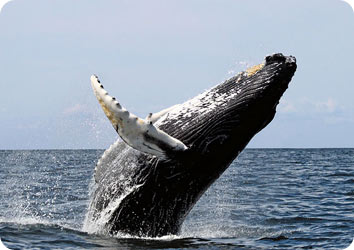Humpback whales are some of the smartest creatures in the oceans. They sometimes catch fish as teams, and they “sing” complex songs that probably play a role in mating. And their brains have several things in common with the human brain -- including different roles for the two sides of the brain.
 Humpback whale breaching the surface. Credit: Wikipedia
Humpback whale breaching the surface. Credit: WikipediaHumpbacks are among the oceans’ giants. Adults grow up to 50 feet long, and weigh about 40 tons. They feed by filtering small fish and other organisms from the water.
Sometimes, they fish as teams. They blow bubbles into the water to “herd” schools of fish, then swim up into the net of bubbles to gorge themselves.
Humpbacks sometimes feed on the bottom -- and that’s how researchers found that they may have the same sort of “left brain-right brain” split as people.
The whales scrape and scratch their jaws on the rocky bottom. Researchers studied the scrapes on a group of whales in Massachusetts Bay. They found that about 80 percent of the group had scrapes only on the right jaw, while 20 percent had scrapes only on the leftjaw. None of the whales had scrapes on both jaws.
What’s more, the whales tended to favor the same side the scrapes were on when they breached the surface with their heads, tails, or flippers.
The findings suggest that the whales are either “left handed” or “right handed.” And since they favor one side over the other, that could mean that the two halves of the humpback’s brain serve different roles, just like the brains of other smart creatures -- including people.

